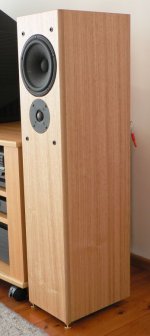to salas and rabbitz
Well , it does seem clever -{and I like your choice of final phrase salas !}- as with the polarity reversal in such case we do get addition instead of a notch in that narrow frequency band around the half-wavelength frequency , but for the majority of the bandwidth , both above and below where the phase shift is not so severe -{and in places its fairly low shift}- we have the portion of the signal above the halfwave frequency and the portion of the signal below the halfwave frequency arriving in opposite polarity at the listener's ears , and some of us can hear this polarity effect to a more disturbing degree than others .
Partly I think the audibility of the polarity difference depends on how much signal processing was done to the original program material the listener prefers , and particually if done with any of :- medium or slow attack time Compressors or Limiters ; large amounts of frequency selective equalization ; time/phase altering effects' devices .
Also , whilst flat response at the centre frequency , there will be some ripple both above and below in the nearby bands owing to the specific distance between the centres no longer being very close to a half-wavelength . The amplitude of this ripple will depend on the slope of the filters used for the cross-over .
rabbitz , thanks again for the photo - that is the one I saw in the other thread we conversed in -{"2-way with 8531G Revelator"}- and was refering to here-above .
I would like to try a curved baffle - sides at least - to reduce the diffraction effects' result of crossing the tweeter over fairly low as it will radiate 180 degrees there . I'd like to curve the edges of the top also , but to do both with large radius will be difficult - I'm still thinking about it .
This thread got a long way down the list in only 4 days ! - there is a lot of activity in this forum recently , and its good to see such !!
salas said:Physical distance of sonic emission centres between drivers translates to phase shift. If it is severe, a polarity inversion that restores it, is indeed in a manner of speaking 'real positive'.
Well , it does seem clever -{and I like your choice of final phrase salas !}- as with the polarity reversal in such case we do get addition instead of a notch in that narrow frequency band around the half-wavelength frequency , but for the majority of the bandwidth , both above and below where the phase shift is not so severe -{and in places its fairly low shift}- we have the portion of the signal above the halfwave frequency and the portion of the signal below the halfwave frequency arriving in opposite polarity at the listener's ears , and some of us can hear this polarity effect to a more disturbing degree than others .
Partly I think the audibility of the polarity difference depends on how much signal processing was done to the original program material the listener prefers , and particually if done with any of :- medium or slow attack time Compressors or Limiters ; large amounts of frequency selective equalization ; time/phase altering effects' devices .
Also , whilst flat response at the centre frequency , there will be some ripple both above and below in the nearby bands owing to the specific distance between the centres no longer being very close to a half-wavelength . The amplitude of this ripple will depend on the slope of the filters used for the cross-over .
rabbitz , thanks again for the photo - that is the one I saw in the other thread we conversed in -{"2-way with 8531G Revelator"}- and was refering to here-above .
I would like to try a curved baffle - sides at least - to reduce the diffraction effects' result of crossing the tweeter over fairly low as it will radiate 180 degrees there . I'd like to curve the edges of the top also , but to do both with large radius will be difficult - I'm still thinking about it .
This thread got a long way down the list in only 4 days ! - there is a lot of activity in this forum recently , and its good to see such !!
Offcourse you are right about wideband effects, I did not expand the case since we were focusing in the transition band, plus there things are very audible vs lower and higher especially in a two way design. Cheers.
